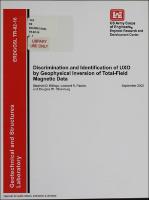Please use this identifier to cite or link to this item:
https://hdl.handle.net/11681/10524| Title: | Discrimination and identification of UXO by geophysical inversion of total-field magnetic data |
| Authors: | University of British Columbia. Department of Earth and Ocean Sciences Billings, Stephen D. Pasion, Leonard R. Oldenburg, Douglas W., 1946- |
| Keywords: | Discrimination Geophysics Geophysical exploration Geophysical surveys Geophysical methods Inversions Magnetic dipoles Munitions Ordnance Explosives Unexploded ordnance UXO |
| Publisher: | Geotechnical and Structures Laboratory (U.S.) Engineer Research and Development Center (U.S.) |
| Series/Report no.: | ERDC/GSL TR ; 02-16. |
| Description: | Technical Report Abstract: A dipole inversion method was developed and successfully applied to the discrimination and identification of unexploded ordnance using total-field magnetometry. A black-white classification of anomalies as ordnance/nonordnance is not possible using magnetics because some nonordnance items are indistinguishable from UXO. We found the best strategy is to rank items according to the likelihood they are UXO. The ranking can be achieved by several methods: the best was to rank on the basis of the amount of remnant magnetization required to make the anomaly match one of the ordnance items in a predefined library. The discrimination method had the potential to reduce the number of excavations at an impact site in Montana (Guthrie Road) by half, yet still yielded all the ordnance. The method requires complete or a least partial shock demagnetization of ordnance, otherwise it is not possible to reliably rank the anomalies. Error analysis indicated that recovered dipole moments are relatively well constrained. However, identification of the anomaly source is difficult using the recovered dipole moment due to nonuniqueness. The dipole moment is the product of magnetization with volume, and a change in volume can be compensated by a change in magnetization by varying the orientation of the item relative to the Earth's field. By recognizing that there is a finite number of ordnance types, correct identification at Guthrie Road could by achieved about 55 percent of the time. Attempts to constrain the orientation (and hence ordnance dimension) by recovering higher-order moments (quadrupole and octupole) of the body did not improve our ability to discriminate or identify. |
| Rights: | Approved for public release; distribution is unlimited. |
| URI: | http://hdl.handle.net/11681/10524 |
| Appears in Collections: | Technical Report |
Files in This Item:
| File | Description | Size | Format | |
|---|---|---|---|---|
| ERDC-GSL-TR-02-16.pdf | 10.27 MB | Adobe PDF |  View/Open |